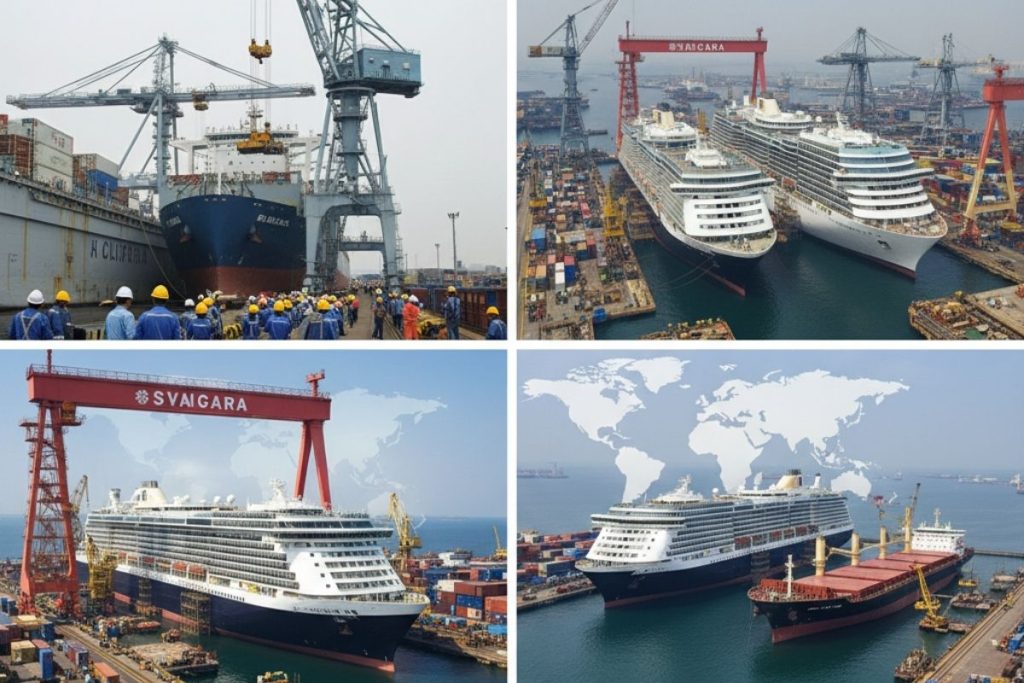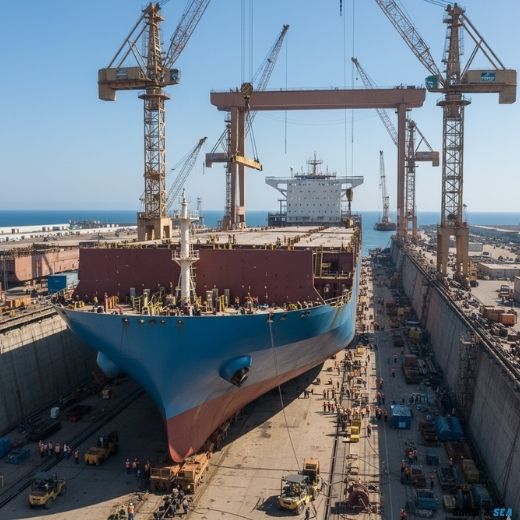When we talk about car manufacturing companies, what comes to mind? Is it Toyota? Honda? Hyundai Motor Group? Or maybe Tesla? Surely, several companies come to mind. Just like the automobile industry has its giants, the maritime world has its shipbuilding powerhouses.
Have you ever wondered where these largest ships are built? Who are the pioneers behind these massive vessels?
In this article, we’ll take a closer look at the largest shipbuilding companies in the world, how they operate, and what makes them leaders in the maritime industry.
The Global Shipbuilding Landscape
The shipbuilding industry is a major player in the global economy. It facilitates over 80% of international trade by volume. By today, the shipbuilding market is growing. In 2025, the market is expected to reach USD 206.89 billion. By 2029 the expectation is to grow to USD 259.09 billion. Asia continues to dominate the global shipbuilding output. Countries like China, South Korea, and Japan produce the majority of new ships by tonnage.
1. China State Shipbuilding Corporation (CSSC) – China
China State Shipbuilding Corporation (CSSC) is the largest shipbuilding company in the world. This was established in 1999, and the headquarters is in Beijing. In 2019 the China State Shipbuilding Corporation merged with the China Shipbuilding Industry Corporation. This merger controls more than 17% of the world’s shipbuilding market.
CSSC operates numerous shipyards across China, including Jiangnan, Hudong-Zhonghua, Dalian, and Guangzhou Shipyard. These facilities cover a wide range of vessel constructions, from container ships, oil tankers, bulk carriers, and LNG carriers to naval vessels and high-tech research ships. CSSC’s shipyards have advanced technologies, automated production lines, and large dry docks capable of building the world’s largest ships.
2. Hyundai Heavy Industries (HHI) – South Korea
Hyundai Heavy Industries (HHI) was founded in 1972. It ranks among the largest shipping companies in the world. HHI has built a reputation for constructing some of the largest and most advanced vessels globally. The company builds mega container ships, oil tankers, LNG carriers, and offshore rigs.
HHI’s main shipyard in Ulsan spans 1.3 million square meters. The company also operates multiple facilities specializing in ship engines, marine equipment, and offshore plants. HHI’s shipyards use automated assembly lines, large cranes, and dry docks that can handle ships over 400,000 deadweight tons (DWT).
3. Daewoo Shipbuilding & Marine Engineering (DSME) – South Korea

Daewoo Shipbuilding & Marine Engineering (DSME) was founded in 1973. The headquarters is in Okpo, South Korea. DSME is now part of Hanwha Ocean. It builds complex offshore structures, LNG carriers, and naval ships. The advanced shipbuilding capabilities in offshore engineering and specialized vessels make DSME a crucial player in global maritime trade.
DSME focuses heavily on technological advancement. The company has implemented digital twin modeling, AI-assisted ship design, automated welding, and robotic assembly systems. DSME is also advancing in green shipbuilding, designing LNG-powered and energy-efficient ships to comply with IMO regulations.
4. Samsung Heavy Industries (SHI) – South Korea
Samsung Heavy Industries (SHI) was founded in 1974 and is headquartered in Geoje, South Korea. It is one of the largest and most technologically advanced shipbuilders in the world. SHI is part of the Samsung Group. They have a global reputation for constructing high-value vessels and complex offshore structures. The company plays a critical role in South Korea’s dominance in the shipbuilding industry.
SHI also focuses on eco-friendly ship designs and digital technologies to ensure their ships meet global safety and environmental standards. By focusing on high-specification ships and offshore structures, SHI maintains a competitive edge in global maritime engineering. Despite facing challenges, the company remains resilient, focusing on technological advancements and strategic partnerships to sustain its position.
5. Fincantieri S.p.A. – Italy
Fincantieri S.p.A. is Europe’s largest shipbuilding company. It was founded in 1959 and headquartered in Trieste, Italy. Fincantieri operates multiple shipyards across Italy, including in Monfalcone, Marghera, and Castellammare di Stabia, along with international facilities in the United States and Romania. They are the leader in cruise ship construction, naval vessels, and eco-friendly ship designs.
Fincantieri is at the forefront of green shipbuilding and technological innovation. The company has played a key role in Europe’s maritime industry and continues to expand its global footprint. In 2025, Fincantieri secured a €9 billion contract with Norwegian Cruise Line to build four next-generation cruise ships.
6. Imabari Shipbuilding – Japan

Imabari is the largest shipbuilding company in Japan. It was founded in 1901 and headquartered in Imabari, Japan. As Japan’s largest shipbuilder, Imabari focuses on constructing bulk carriers and container vessels. The company is one of the largest shipbuilders in Asia. They play a critical role in maintaining Japan’s competitive edge in commercial shipbuilding.
Imabari operates multiple shipyards across Japan, including in Imabari, Marugame, and Niihama. There are large dry docks, modular construction systems, and advanced automated assembly lines in these shipyards. Imabari Shipbuilding emphasizes sustainability and innovation. Its reputation for reliability, fuel efficiency, and environmental compliance has earned trust from global clients.
7. Meyer Werft – Germany
Meyer Werft specializes in luxury cruise ships. It is one of the top shipbuilders in Europe. The company was founded in 1795. It has centuries of shipbuilding experience. Meyer Werft has earned a global reputation for producing high-quality, innovative, and eco-friendly vessels. Their cruise ships operate worldwide, bringing millions of passengers on voyages every year.
The shipyard builds ships for world-famous cruise lines like Royal Caribbean, Disney Cruise Line, and AIDA Cruises The company occasionally undertakes unique projects that require innovative engineering solutions. Because of their high standards of construction, they have helped to establish the company as a leader in the global cruise ship market.
8. Huntington Ingalls Industries (HII) – United States
HII is the largest military shipbuilder in the U.S. The HII was founded in 2011. They specialize in aircraft carriers, destroyers, and submarines. HII operates two primary divisions: Newport News Shipbuilding and Ingalls Shipbuilding. The Newport News shipyard is the largest industrial facility in Virginia. They have massive dry docks, automated assembly lines, and advanced fabrication facilities.
Ingalls Shipbuilding, based in Pascagoula, Mississippi. Both shipyards integrate digital design tools, robotic assembly, and modular construction techniques. The company also invests in sustainable shipbuilding practices. HII plays a strategic role in the United States’ naval dominance and defense readiness. The company not only strengthens U.S. maritime security but also influences shipbuilding practices worldwide.
9. China Merchants Industry Holdings – China
China Merchants Industry Holdings (CMIH) is a major shipbuilding company under the China Merchants Group. It is one of China’s oldest and most influential state-owned enterprises. The company began in 1872 as part of the original China Merchants Steam Navigation Company. CMIH plays an important role in China’s shipbuilding industry.
CMIH operates several shipyards. They include the prominent shipyards Huizhou Shipyard and Shenzhen Shipyard. Facilities like large dry docks, automated production lines, and modern fabrication technologies allow CMIH to produce a wide range of vessels. From container ships and bulk carriers to offshore support vessels and specialized ships, construct here.
10. STX Offshore & Shipbuilding – South Korea
STX Offshore & Shipbuilding was founded in 1977. It is headquartered in Changwon, South Korea. STX is an important player in the global shipbuilding industry. The company had to face financial challenges in recent years. Despite financial challenges, STX maintains advanced shipyards with dry docks, modular construction, and automated assembly systems.
STX focuses on technological improvements to stay competitive. They also explore eco-friendly and fuel-efficient ship designs to comply with IMO regulations and global environmental standards. STX ranks among the top three shipbuilders in South Korea.
Final Thought
Just as car manufacturers like Toyota, Honda, and Tesla dominate the roads, shipbuilding giants like CSSC, HHI, and Fincantieri dominate the seas. The world needs ships that are cleaner, smarter, and more efficient. In 2025, the leading shipbuilders are not just building large vessels. They’re building with purpose to balance scale, innovation, and sustainability. As the industry navigates the challenges and opportunities ahead, these giants will continue to shape the future of global maritime trade.

